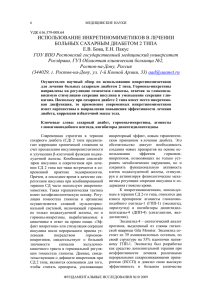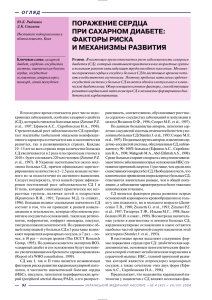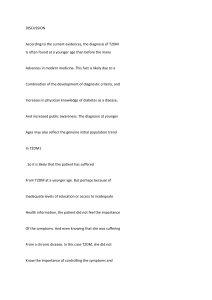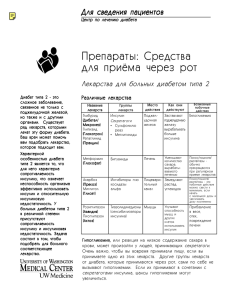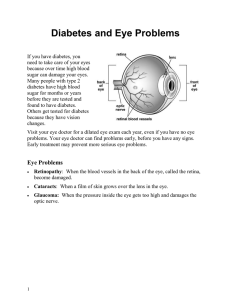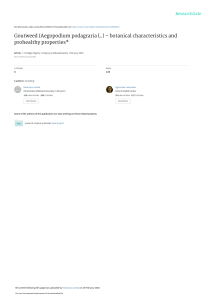Новый ингибитор дипептидил пептидазы-4 госоглиптин
реклама
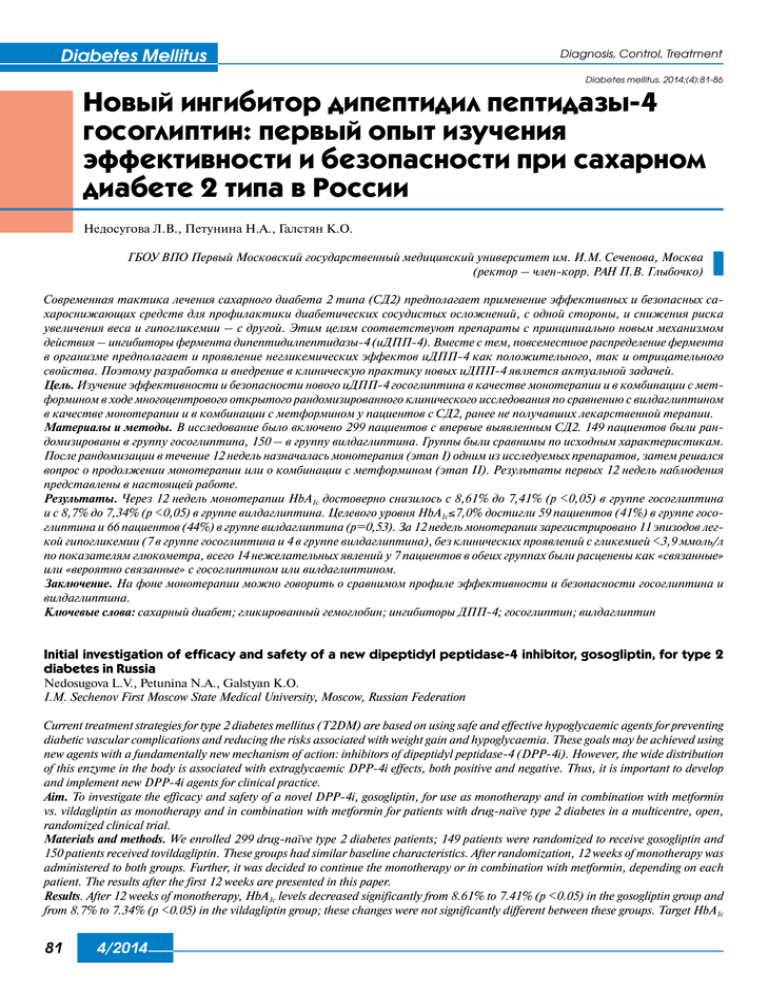
Diabetes Mellitus Diagnosis, Control, Treatment Diabetes mellitus. 2014;(4):81-86 Новый ингибитор дипептидил пептидазы-4 госоглиптин: первый опыт изучения эффективности и безопасности при сахарном диабете 2 типа в России Недосугова Л.В., Петунина Н.А., Галстян К.О. ГБОУ ВПО Первый Московский государственный медицинский университет им. И.М. Сеченова, Москва (ректор – член-корр. РАН П.В. Глыбочко) Современная тактика лечения сахарного диабета 2 типа (СД2) предполагает применение эффективных и безопасных сахароснижающих средств для профилактики диабетических сосудистых осложнений, с одной стороны, и снижения риска увеличения веса и гипогликемии – с другой. Этим целям соответствуют препараты с принципиально новым механизмом действия – ингибиторы фермента дипептидилпептидазы-4 (иДПП-4). Вместе с тем, повсеместное распределение фермента в организме предполагает и проявление негликемических эффектов иДПП-4 как положительного, так и отрицательного свойства. Поэтому разработка и внедрение в клиническую практику новых иДПП-4 является актуальной задачей. Цель. Изучение эффективности и безопасности нового иДПП-4 госоглиптина в качестве монотерапии и в комбинации с метформином в ходе многоцентрового открытого рандомизированного клинического исследования по сравнению с вилдаглиптином в качестве монотерапии и в комбинации с метформином у пациентов с СД2, ранее не получавших лекарственной терапии. Материалы и методы. В исследование было включено 299 пациентов с впервые выявленным СД2. 149 пациентов были рандомизированы в группу госоглиптина, 150 – в группу вилдаглиптина. Группы были сравнимы по исходным характеристикам. После рандомизации в течение 12 недель назначалась монотерапия (этап I) одним из исследуемых препаратов, затем решался вопрос о продолжении монотерапии или о комбинации с метформином (этап II). Результаты первых 12 недель наблюдения представлены в настоящей работе. Результаты. Через 12 недель монотерапии НbА1с достоверно снизилось с 8,61% до 7,41% (р <0,05) в группе госоглиптина и с 8,7% до 7,34% (р <0,05) в группе вилдаглиптина. Целевого уровня НbА1с≤7,0% достигли 59 пациентов (41%) в группе госоглиптина и 66 пациентов (44%) в группе вилдаглиптина (р=0,53). За 12 недель монотерапии зарегистрировано 11 эпизодов легкой гипогликемии (7 в группе госоглиптина и 4 в группе вилдаглиптина), без клинических проявлений с гликемией <3,9 ммоль/л по показателям глюкометра, всего 14 нежелательных явлений у 7 пациентов в обеих группах были расценены как «связанные» или «вероятно связанные» с госоглиптином или вилдаглиптином. Заключение. На фоне монотерапии можно говорить о сравнимом профиле эффективности и безопасности госоглиптина и вилдаглиптина. Ключевые слова: сахарный диабет; гликированный гемоглобин; ингибиторы ДПП-4; госоглиптин; вилдаглиптин Initial investigation of efficacy and safety of a new dipeptidyl peptidase-4 inhibitor, gosogliptin, for type 2 diabetes in Russia Nedosugova L.V., Petunina N.A., Galstyan K.O. I.M. Sechenov First Moscow State Medical University, Moscow, Russian Federation Current treatment strategies for type 2 diabetes mellitus (T2DM) are based on using safe and effective hypoglycaemic agents for preventing diabetic vascular complications and reducing the risks associated with weight gain and hypoglycaemia. These goals may be achieved using new agents with a fundamentally new mechanism of action: inhibitors of dipeptidyl peptidase-4 (DPP-4i). However, the wide distribution of this enzyme in the body is associated with extraglycaemic DPP-4i effects, both positive and negative. Thus, it is important to develop and implement new DPP-4i agents for clinical practice. Aim. To investigate the efficacy and safety of a novel DPP-4i, gosogliptin, for use as monotherapy and in combination with metformin vs. vildagliptin as monotherapy and in combination with metformin for patients with drug-naïve type 2 diabetes in a multicentre, open, randomized clinical trial. Materials and methods. We enrolled 299 drug-naïve type 2 diabetes patients; 149 patients were randomized to receive gosogliptin and 150 patients received tovildagliptin. These groups had similar baseline characteristics. After randomization, 12 weeks of monotherapy was administered to both groups. Further, it was decided to continue the monotherapy or in combination with metformin, depending on each patient. The results after the first 12 weeks are presented in this paper. Results. After 12 weeks of monotherapy, HbA1c levels decreased significantly from 8.61% to 7.41% (p <0.05) in the gosogliptin group and from 8.7% to 7.34% (p <0.05) in the vildagliptin group; these changes were not significantly different between these groups. Target HbA1c 81 4/2014 Diagnosis, Control, Treatment Diabetes Mellitus Diabetes mellitus. 2014;(4):81-86 of ≤7.0% was achieved for 59 patients (41%) who took gosogliptin and 66 patients (44%) who took vildagliptin (p=0.53). After 12 weeks of monotherapy, 11 episodes of mild hypoglycaemia occurred (7 on gosogliptin and 4 on vildagliptin), without clinical manifestations of blood glucose levels of <3.9 mmol/l based on metre readings. Only 14 adverse events (7 patients in each group) were assessed as ‘related to’ or ‘probably related to’ gosogliptin or vildagliptin. Conclusion. Our preliminary monotherapy study showed comparable efficacy and safety profiles for gosogliptin and vildagliptin. Keywords: Diabetes; glycated haemoglobin; DPP-4 inhibitors; gosogliptin; vildagliptin DOI: 10.14341/DM2014481-86 T h incidence of type 2 diabetes mellitus (T2DM) he iis expected to globally increase from 6.4% to 8.0% by 2030 [1]. This rapid increase in the incidence b of T2DM is associated with an increased prevalence of obesity, reduced physical activity and increased life span. Improving the glycaemic control remains the main goal of T2DM treatment because it reduces the risk of progression to vascular complications that are the main causes of disability and increased mortality, as shown in numerous prospective randomized clinical studies, including the United Kingdom Prospective Diabetes Study (UKPDS), PROspective pioglitAzone Clinical Trial In macroVascular Events (PROactive), Atherosclerotic Disease, VAscular functioN, and genetiC Epidemiology (ADVANCE), Veterans Affairs Diabetes Trial (VADT) and Action to Control Cardiovascular Risk in Diabetes (ACCORD). However, a meta-analysis of studies on intensifying the glycaemic control demonstrated that diabetes duration, weight gain and severe hypoglycaemia were associated with an increased risk of cardiovascular mortality even with intensive therapy [2]. Therefore, the current strategy for T2DM treatment is based on the maximum efficient glycaemic control, and effective glycaemic control is aimed at reducing the progression of vascular complications. An individual approach for glycaemic control is usually implemented when a disease is diagnosed to avoid the risk of weight gain and development of hypoglycaemic states [3]. Based on these considerations, using hypoglycaemic agents that have proven hypoglycaemic effects, low risks of inducing hypoglycaemia and neutral effects on body weight are currently the most promising. Incretin drugs, including glucagon-like peptide-1 (GLP-1) receptor agonists and dipeptidyl peptidase-4 enzyme inhibitors (DPP-4i, gliptins), meet all these requirements. Gliptins are readily available and convenient to use as they increase native GLP-1 levels when administered orally by blocking the actions of the DPP-4 enzyme destroying incretin and inhibit glucagon secretion. Further, DPP-4i can potentially affect non-glycaemic mechanisms of complications because of the abundance of this enzyme in the body. DPP-4 hydrolyses the glycine–proline dipeptide in Gly–Pro–2-naphthylamide. DPP-4 is expressed in most organs and is also found in the serum and on the cell surfaces of T lymphocytes [4]. Owing to its abundance, DPP-4 interacts with various substrates, participating in the pathogenesis of autoimmune and inflammatory diseases and affects cellular apoptosis and tumour growth [5]. Therefore, inhibiting DPP-4 potentially involves multiple effects. However, only hypoglycaemic effects of DPP-4i, which occur through the aforementioned mechanism, are used in clinical practice. DPP-4 activity increases under conditions of chronic hyperglycaemia, contributing to an increased postprandial hyperglycaemia by inactivating GLP-1 [6]. This increased enzyme activity is most closely associated with increased glucose levels in microvascular endothelial cells. Therefore, inhibiting this enzyme with gliptins suggests both antihyperglycaemic and angioprotective effects [7]. The discovery of cardioprotective, hypotensive and anti-inflammatory properties of DPP-4i has encouraged the development of new drugs in this group that not only facilitate reducing the progression of cardiovascular complications associated with T2DM but also are potentially indicated the treatment of autoimmune diseases, such as multiple sclerosis, rheumatoid arthritis, ulcerative colitis, allograft rejection reactions [8–11] and Parkinson’s disease [12]. DPP-4, which was identified as CD26 protein on the surface of T lymphocytes, was probably involved in the pathogenesis of type 1 diabetes mellitus (T1DM) by regulating the differentiation of T lymphocytes for increasing their killer activity. Antihyperglycaemic effects of gliptins have also been shown in autoimmune T1DM [13]. However, the abundance of this enzyme in the body also suggests that adverse side effects result upon its inhibition. A risk of acute pancreatitis caused by increased intestinal GLP-1 when using DPP-4i was the first issue of concern for clinicians. The results of the latest meta-analysis demonstrated that the incidence of pancreatitis was low after treatment with incretins and that these drugs did not increase the risk of pancreatitis [14]. After treatment with gliptins, adverse side effects in the gastrointestinal tract are less common than after treatment with metformin or GLP-1 receptor agonists [15]. Another important issue is the possible pro-oncogenic or, conversely, antitumor effects of DPP-4i. It is known that some tumour cells abnormally secrete DPP-4. However, DPP-4/CD26 is considered to be an enzyme that can 4/2014 82 Diabetes Mellitus Diagnosis, Control, Treatment Diabetes mellitus. 2014;(4):81-86 suppress tumour formation. Suppressing DPP-4/CD26 expression with gliptins can, in some cases, reduce the risk of cancer (hepatocellular carcinoma, renal cell carcinoma, astrocytomas and mesotheliomas of the brain and chronic lymphocytic leukaemia), while it can increase the risk of other cancers (prostate cancer, ovarian carcinoma, small cell lung cancer, melanoma) [5]. The most common side effects associated with treatment with gliptins, such as nasopharyngitis, headache, nausea and allergy, are also associated with inhibiting DPP-4 activity that results in increased half-lives of bradykinin and substance P, resulting in increased vascular permeability, particularly with the simultaneous administration of ACE inhibitors [16]. At present, FDA and EU approved gliptins, such as sitagliptin, vildagliptin, saxagliptin, linagliptin and alogliptin, are extensively used in clinical practice. Pfizer assigned exclusive rights to develop, manufacture and register a novel molecule, gosogliptin, to Satereks (subsidiary company of the largest Russian non-state research centre in the field of living systems; KhimRar High Technology Center) during the St. Petersburg International Economic Forum, 2012. Gosogliptin is a novel reversible inhibitor of DPP-4. Seven clinical trials (CTs) of gosogliptin have been conducted to date, including five phase 1 trials and two international multi-centre phase 2 CTs. These studies included 624 patients who received 0.3–300 mg gosogliptin. Pharmacokinetics studies demonstrated a rapid absorption of gosogliptin after a single oral administration under fasting conditions, with a mean Tmax of 0.5–1.5 h. The serum concentration after absorption was biphasic. Furthermore, the half-life (T1/2) was 15.1–27.4 h for doses ranging from 0.3 to 300 mg. Gosogliptin administration resulted in a dose-dependent decrease in DPP-4 activity, with the maximal inhibition of enzymatic activity occurring at 1 h after administration for all doses used under fasting conditions. The mean DPP-4 inhibition at 24 h after administration was >80% with a dose of 30 mg. Based on the results of phase IIb CTs, a daily dose of 20 mg and 30 mg was selected as basic doses for repeated use in T2DM patients. In those studies, the maximum duration of daily gosogliptin administration was 12 weeks. A study on the efficacy of these doses (20 mg and 30 mg) confirmed there that were statistically significant reductions in HbA1c levels at 12 weeks after beginning treatment compared to a placebo administered along with stable doses of metformin (placebo-corrected values: –0.79% and –0.92% for 20 mg and 30 mg, respectively). Patients who received 20 mg or 30 mg also had statistically significant decreases in their fasting plasma glucose levels and a higher probability of achieving the target HbA 1c value of 7.0% compared with patients in the placebo group. In general, in phase I and II trials, gosogliptin demonstrated good tolerability and safety comparable to those observed for patients on placebo. 83 4/2014 Aim Our aim was to conduct a multi-centre, open, randomized clinical trial on the efficacy and safety of PDD-4i, gosogliptin, when used as monotherapy and in combination with metformin compared with vildagliptin as monotherapy and in combination with metformin for drug-naïve T2DM patients. Materials and methods A phase III multi-centre, open, randomized clinical trial was initiated at 26 clinical centres in Russia in April of 2013 to examine the efficacy and safety of gosogliptin used as monotherapy and in combination with metformin compared with vildagliptin used as monotherapy and in combination with metformin for drug-naïve T2DM patients. Statistical analysis of data from the first 12 weeks of therapy with gosogliptin and the reference drug vildagliptin for all enrolled patients was conducted in May 2014 in accordance with the CT protocol; these data have been discussed in this paper. According to the CT protocol, newly diagnosed T2DM patients were enrolled. After they completed all required examination procedures, including providing signed informed consent, complying with inclusion/exclusion criteria and the training period at the School of Diabetes, they were randomized into study groups to receive monotherapy either gosogliptin or vildagliptin. The monotherapy period lasted 12 weeks, following which it was decided to either continue with monotherapy or combine it with metformin based on a carbohydrate metabolism assessment. In general, the duration of the active treatment period of this study was 36 weeks, followed by a 4-week follow-up period. Altogether, 299 patients were randomized in this study; 149 in the gosogliptin group and 150 in the vildagliptin group. Ten patients discontinued the study early after randomization: 2 (1.3%) in the vildagliptin group and 8 (5.4%) in the gosogliptin group; these proportions were not significantly different (p = 0.061). The main causes for early discontinuation from this study included significant CT protocol violations, significant adverse events (AEs), serious adverse events, withdrawal of informed consent and lost contact with the patient. The groups of randomized patients were comparable with regard to demographic and other baseline characteristics, including gender, age, race, body mass index (BMI), co-morbidities, HbA 1c levels and fasting plasma glucose (FPG) levels (Table 1). Glycaemia was determined using the hexokinase method. Diabetes Mellitus Diagnosis, Control, Treatment Diabetes mellitus. 2014;(4):81-86 Table 1 Demographic characteristics of study population Gender, m/f Age, years BMI Systolic Blood Pressure, mmHg HbA1c,, % FPG, mmol/L Gosogliptin 63/83 55.7 (27–75) 32.08 (SD: 4.315) Vildagliptin 77/73 56.72 (29–77) 31.78 (SD, 4.266), 134 (107–160) 132.6 (100–163) 8.61 (SD: 0.98) 9.51 (SD: 2.485) 8.7 (SD: 1.05) 9.50 (SD: 2.795) SD = standard deviation HbA1c levels were determined by capillary electrophoresis using a CapillarysNbA1c instrument (Sebia) certified in accordance with NGSP and IFCC guidelines and standardized in accordance with reference values approved by NACB and DCCT. The enrolled patients were provided with glucometers and test strips for glycaemic control. They were also provided diabetes self-control diaries and instructed on the use of the glucometer and how to enter details in the selfcontrol diary. In accordance with the CT protocol, the initial drug doses used in this study were 20 mg gosogliptin once in the morning and 50 mg vildagliptin once in the morning. After 4 weeks of therapy, patients who did not reach the therapy targets based on self-control data underwent dose titration of the study drug or reference drug, i.e. an increase in the gosogliptin dose to 30 mg once in the morning or an increase in the vildagliptin dose to 100 mg per day (50 mg each in the morning and in evening). The monotherapy stage was further continued for 8 weeks (total monotherapy was for 12 weeks). According to the diary data, the following variables that did not meet the therapy targets were used to evaluate the advisability of dose titration: more than half of the fasting glucose level values of ≥7.0 mmol/L and/or glucose level values at 2 h after a meal of ≥9.0 mmol/L. Measurements (7 control points per day) were made for at least 3 days during the week prior to the next visit of the patient to the research centre. week 12 of active treatment, at the end of the monotherapy stage, HbA1c levels markedly decreased in both groups and were 7.41% after treatment with the study drug gosogliptin and 7.34% after treatment with the reference drug vildagliptin. Thus, mean decreases in HbA1c levels after 12 weeks of monotherapy were 0.91% (p <0.05) with gosogliptin (study drug) and 1.05% (p < 0.05) with vildagliptin (reference drug). HbA1c level dynamics are shown in Fig. 1. The difference between these groups after treatments according to the protocol for a reduction in HbA 1c levels was 0.113% (95% CI: –0.133–0.359), which definitely indicated that the efficacy of the study drug gosogliptin was similar to that of the reference drug vildagliptin. Another important criterion to assess the efficacy was the number of patients who achieved treatment targets (HbA1c of ≤7%) by the end of the 12 weeks of active treatment. Data were obtained for 292 patients (141 in the gosogliptin group and 148 in the vildagliptin group). Of these patients, the specified target value was achieved in 59 patients (41%) in the gosogliptin group and in 66 patients (44.6%) in the vildagliptin group; these proportions were not statistically significant (p = 0.53). Overall, 125 patients (42.8%) in both groups reached their targets for monotherapy. The safety variables should also be noted. In total, 83 AEs were reported; of which, only 14 AEs in 7 patients in each group were regarded by investigators as “related to” or “probably related to” the study drug or reference drug. These included fasting hyperglycaemia, constipation, side stitches, allergic reaction, elevated levels of total bilirubin and transaminases, osteochondrosis, headache, dizziness, glycosuria and itchy skin. In total, 11 episodes of mild hypoglycaemia (7 in the gosogliptin group and 4 in the vildagliptin group) were reported during 12 weeks of active treatment at the monotherapy stage; however, the difference was not statistically significant. These episodes had no clinical significance as these data were for registered glucometer readings of <3.9 mmol/L in the absence of clinical manifestations of hypoglycaemia. During the monotherapy stage, a dose correction (increase) for the study drug or reference drug was required for 118 (79.3%) patients in the gosogliptin group and for 118 (78.7%) patients in the vildagliptin group. Assessments of the efficacy variables provided convincing results with regard to the primary endpoint, change in HbA1c levels, at the end of the 12-week monotherapy compared with baseline values. At baseline (week 0), mean HbA1c levels were 8.61% in the gosogliptin group and 8.7% in the control group. By HbA1c level dynamics, % 9,0 Results and discussion 8,5 8,0 7,5 7,0 6,5 В1 (Week -2) В3 (Week 0) В5 (Week 12) Gosogliptin group Vildagliptin group Figure 1. HbA1c level dynamics in the study groups 4/2014 84 Diabetes Mellitus Diagnosis, Control, Treatment Diabetes mellitus. 2014;(4):81-86 Conclusion Funding and conflicts of interest Therefore, our preliminary data analysis suggests that the efficacy and safety of gosogliptin during this 12 week trial were comparable to those of vildagliptin. We can assume that the study drug gosogliptin will retain its efficacy and safety profiles comparable to those of vildagliptin (most popular DPP-4i reference drug in Russia) at the end of 36 weeks of active therapy. The authors declare that there was no funding for the preparation and review of this manuscript. The authors are involved in a phase III trial of gosogliptin at the Research Centre of the City Clinical Hospital No 67 (Moscow). The statistical data based on the results of this preliminary analysis were provided by the clinical trial sponsor, Satereks. R E F E R E NC E S 1. 2. 3. 4. 5. 6. 7. 8. 85 Cунцов ЮИ. Современные сахароснижающие препараты, используемые в России при лечении сахарного диабета 2 типа. Сахарный диабет. 2012;1: 6–10. [ Suntsov YI. Modern antihyperglycemic agents prescribed in Russia for type 2 diabetes mellitus. Diabetes mellitus. 2012;(1):6–9.] doi: 10.14341/2072-0351-5971 Mannucci E, Monami M, Lamanna C, Gori F, Marchionni N. Prevention of cardiovascular disease through glycemic control in type 2 diabetes: A meta-analysis of randomized clinical trials. Nutrition, Metabolism and Cardiovascular Diseases 2009;19(9):604–612. doi: 10.1016/j.numecd.2009.03.021 Алгоритмы специализированной медицинской помощи больным сахарным диабетом. Под редакцией И.И. Дедова, М.В. Шестаковой (6-й выпуск). Сахарный диабет. 2013;(1s):1–121. [ Dedov I, Shestakova M, Aleksandrov A, Galstyan G, Grigoryan O, Esayan R, et al. Standards of specialized diabetes care. Edited by Dedov II, Shestakova MV (6th edition). Diabetes mellitus. 2013;(1S):1–120.] doi: 10.14341/DM20131S1-121 Mentlein R, Heymann E, Scholz W, Feller AC, Flad H. Dipeptidyl peptidase IV as a new surface marker for a subpopulation of human T-lymphocytes. Cellular Immunology 1984;89(1):11–19. doi: 10.1016/0008-8749(84)90192-8 Zhаu Y, Yang L, Zhou Z. Dipeptidyl peptidase-4 inhibitors: Multitarget drugs, not only antidiabetes drugs. Journal of Diabetes 2014;6(1):21–29. Mannucci E, Pala L, Ciani S, Bardini G, Pezzatini A, Sposato I, et al. Hyperglycaemia increases dipeptidyl peptidase IV activity in diabetes mellitus. Diabetologia 2005;48(6):1168–1172. doi: 10.1007/s00125-005-1749-8 Pala L, Pezzatini A, Dicembrini I, Ciani S, Gelmini S, Vannelli BG, et al. Different modulation of dipeptidyl peptidase-4 activity between microvascular and macrovascular human endothelial cells. Acta Diabetol 2010;49(Suppl 1):S59–59. doi: 10.1007/s00592-010-0195-3 Hafler DA, Fox DA, Manning ME, Schlossman SF, Reinherz EL, Weiner HL. In vivo Activated T Lymphocytes in the 4/2014 9. 10. 11. 12. 13. 14. 15. 16. Peripheral Blood and Cerebrospinal Fluid of Patients with Multiple Sclerosis. N Engl J Med 1985;312(22):1405–1411. doi: 10.1056/NEJM198505303122201 Hildebrandt M, Rose M, Rüter J. Dipeptidyl Peptidase IV (DP IV, CD26) in Patients with Inflammatory Bowel Disease. Scand J Gastroenterol 2001;36(10):1067–1072. doi: 10.1080/003655201750422675 Gotoh H, Hagihara M, Nagatsu T, Iwata H, Miura T. Activities of dipeptidyl peptidase II and dipeptidyl peptidase IV in synovial fluid from patients with rheumatoid arthritis and osteoarthritis. Clin Chem 1989;35(6):1016–1018. PubMed PMID: 2567214 Christopherson 2nd KW, Hangoc G, Mantel CR, Broxmeyer HE. Modulation of hematopoietic stem cell homing and engraftment by CD26. Science 2004;305(5686):1000–1003. doi: 10.1126/science.1097071 Wang Y, Hoffer BJ, Greig NH. DPP-4 Inhibitors for the Treatment of Parkinson's Disease. 2011. Available from: https:// www.michaeljfox.org/foundation/grant-detail.php?grant_ id=1339 Ellis SL, Moser EG, Snell-Bergeon JK, Rodionova AS, Hazenfield RM, Garg SK. Effect of sitagliptin on glucose control in adult patients with Type 1 diabetes: a pilot, double-blind, randomized, crossover trial. Diabetic Medicine 2011;28(10):1176–1181. doi: 10.1111/j.1464-5491.2011.03331.x Li L, Shen J, Bala MM, Busse JW, Ebrahim S, Wong E, et al. Incretin treatment and risk of pancreatitis in patients with type 2 diabetes mellitus: systematic review and metaanalysis of randomised and non-randomised studies. BMJ 2014;348:g2366. doi: 10.1136/bmj.g2366. Karagiannis T, Paschos P, Paletas K, Matthews D, Tsapas A. Dipeptidyl peptidase-4 inhibitors for treatment of type 2 diabetes mellitus in the clinical setting: systematic review and metaanalysis. BMJ 2012;344:e1366. doi: 10.1136/bmj.e1369 Karagiannis T, Boura P, Tsapas A. Safety of dipeptidyl peptidase 4 inhibitors: a perspective review. Ther Adv Drug 2014;5(3):138–146. Diabetes Mellitus Diagnosis, Control, Treatment Diabetes mellitus. 2014;(4):81-86 Nedosugova Ludmila Viktorovna Petunina Nina Aleksandrovna Galstyan Karina Oganesovna MD, PhD Professor of the Endocrinology Chair of Postgraduate education institute, I. M. Sechenov First Moscow State Medical University, Moscow, Russian Federation E-mail: [email protected] MD, PhD Professor, Head of the Endocrinology Chair of Postgraduate education institute, I. M. Sechenov First Moscow State Medical University, Moscow, Russian Federation MD PhD-student at Endocrinology Chair of Postgraduate education institute, I. M. Sechenov First Moscow State Medical University, Moscow, Russian Federation 4/2014 DMjournal.ru/ru/articles/catalog/2014_4/2014_4_81 86
